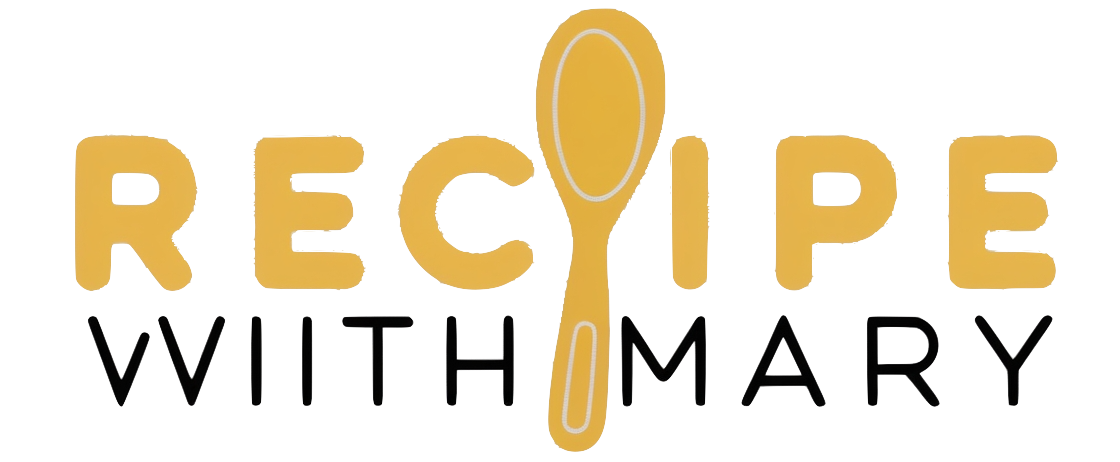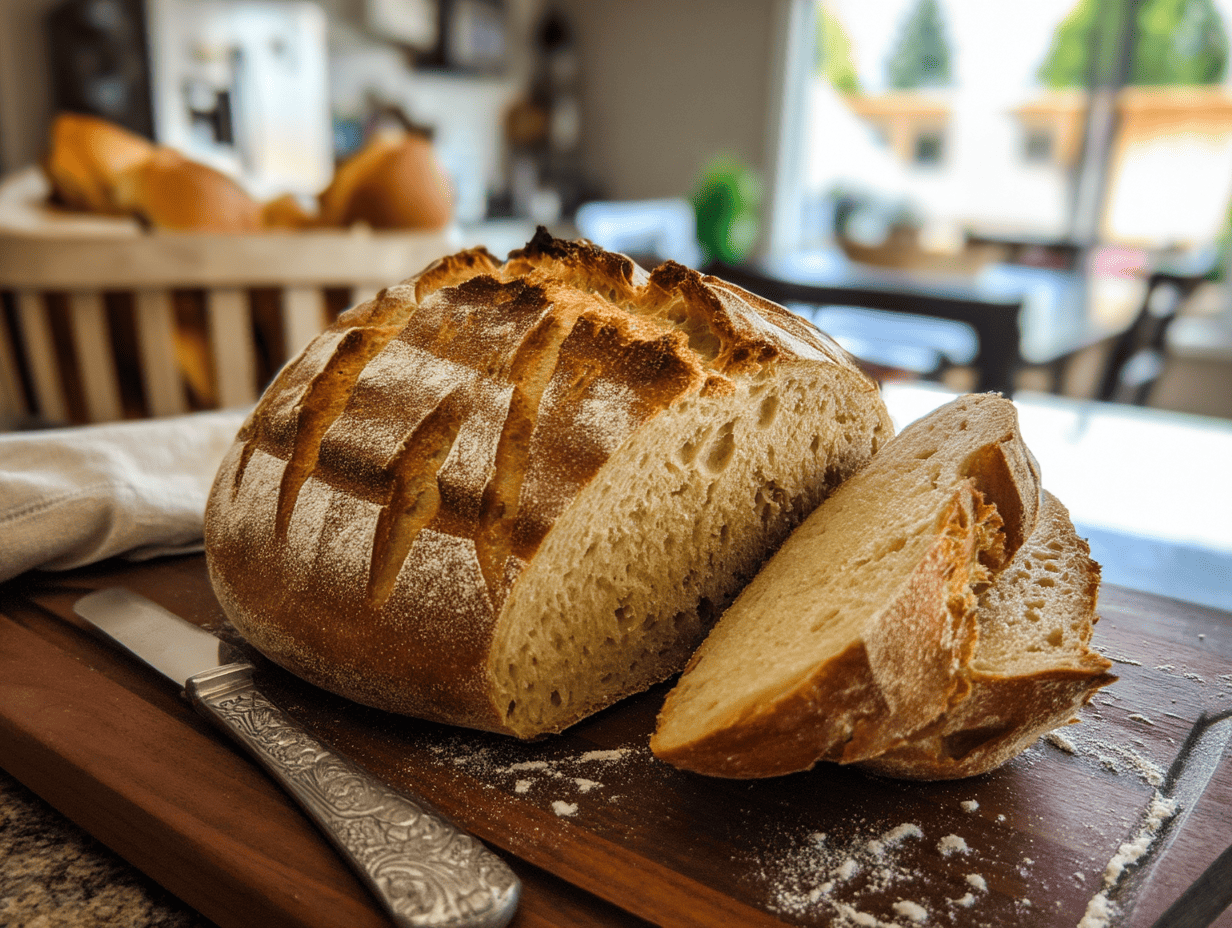I’ll never forget the day my daughter burst into tears over a jar of moldy sourdough starter. We’d been feeding “Bubbles” faithfully for weeks, dreaming of crusty loaves like grandma’s. But vacation happened, life got busy, and our starter died. That heartbreak led me to discover something revolutionary: you can make authentic sourdough bread without a starter. This game-changing method delivers that signature tang and chewy crumb in just 8 hours, not 8 days.
Making sourdough bread recipe without starter sounds impossible, right? But here’s the secret: cultured dairy products contain the same beneficial bacteria that create sourdough’s distinctive flavor. By using Greek yogurt, buttermilk, or sour cream, we’re essentially borrowing someone else’s perfectly maintained culture. This sourdough bread recipe without starter produces genuine sourdough characteristics – the open crumb, crispy crust, and tangy depth – without any starter maintenance. Whether you’re a busy parent or someone who’s failed at traditional sourdough before, this sourdough bread without starter technique makes artisan baking accessible to everyone.
Table of content
Understanding the Science Behind Sourdough Without Traditional Starter
How Cultured Dairy Replaces Wild Yeast Cultures
The magic behind this sourdough bread recipe without starter lies in understanding fermentation science. Traditional sourdough starters cultivate wild yeast (Saccharomyces cerevisiae) and lactobacilli bacteria through flour and water feedings. These microorganisms produce lactic and acetic acids, creating sourdough’s signature tang. When making sourdough bread without starter, cultured dairy products like Greek yogurt contain similar lactobacilli strains – particularly Lactobacillus bulgaricus and Streptococcus thermophilus. When combined with commercial yeast for rising power, these dairy cultures replicate sourdough’s fermentation profile remarkably well in our sourdough bread recipe without starter.
What makes this sourdough without starter substitution so effective? The pH levels tell the story. Traditional sourdough starters maintain a pH between 3.5-4.5, while Greek yogurt sits at 4.0-4.6 – nearly identical. This acidic environment in our sourdough bread recipe without starter encourages the same flavor development and gluten transformation that makes sourdough special. The proteins in dairy also contribute to a tender crumb structure, while natural sugars feed the commercial yeast we add for reliable rising in this no-starter sourdough bread method.
The Chemistry of Flavor Development
Creating authentic sourdough flavor in your sourdough bread recipe without starter requires understanding how acids develop during fermentation. In traditional sourdough, long fermentation produces both lactic acid (mild, yogurt-like) and acetic acid (sharp, vinegar-like). Our sourdough bread without starter method primarily generates lactic acid, creating a milder but distinctly sour flavor profile. By extending fermentation time and controlling temperature in this sourdough recipe without starter, we can enhance acid development and achieve deeper flavor complexity that rivals traditional methods.
Temperature plays a crucial role in flavor chemistry for sourdough bread recipe without starter. Cooler fermentation (65-70°F) promotes acetic acid production for sharper tang, while warmer conditions (75-80°F) favor lactic acid for milder sourness. This knowledge lets you customize your sourdough without starter bread’s flavor profile. Adding a tablespoon of apple cider vinegar can boost acetic acid content, mimicking traditional sourdough’s complexity. The fermentation time in our sourdough bread recipe without starter also matters – longer rises develop more nuanced flavors, though our method caps at 8-12 hours versus traditional sourdough’s 24-48 hour timeline.
Essential Ingredients and Their Roles in No-Starter Sourdough
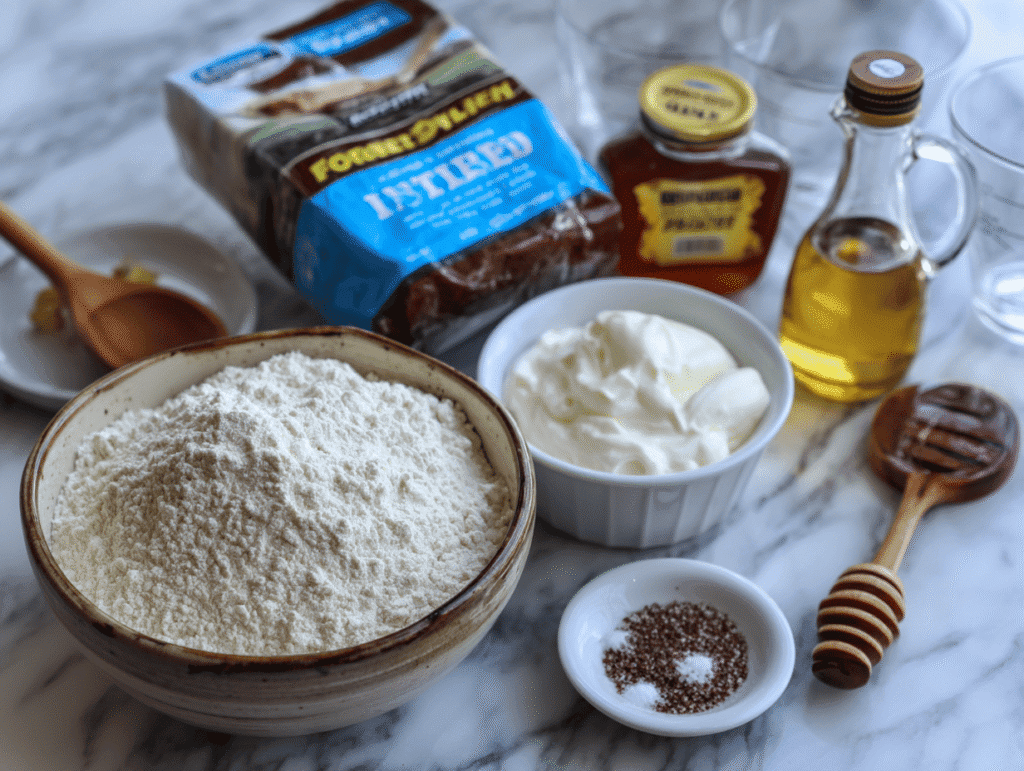
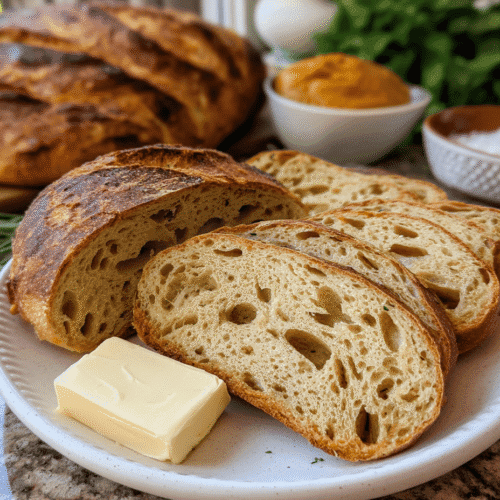
Sourdough Bread Without Starter
Equipment
- Large Mixing Bowl
- Dough Whisk or Wooden Spoon
- Kitchen Towel
- Banneton or Bowl for Proofing
- Dutch Oven
- Bench Scraper
- Lame or Sharp Knife
Ingredients
For the Dough
- 3 3/4 cups bread flour
- 1/4 cup whole wheat flour
- 2 tsp salt
- 1 tsp instant yeast
- 1 cup Greek yogurt full-fat, with live cultures
- 1 cup warm water 80-85°F
- 1 tbsp honey
Optional for Extra Tang
- 1 tbsp apple cider vinegar optional
Instructions
- In a large bowl, whisk together bread flour, whole wheat flour, salt, and instant yeast. Create a well in the center.
- Add Greek yogurt, warm water, and honey to the well. Mix from the center outward with a wooden spoon or dough whisk until a shaggy dough forms. Don’t overmix – lumps are normal.
- Cover bowl with a damp kitchen towel and let rest for 30 minutes (autolyse period).
- Perform stretch and folds: wet your hand, grab one side of dough, stretch up and fold over to opposite side. Rotate bowl quarter turn and repeat 3 more times.
- Cover and begin bulk fermentation at room temperature (70-75°F) for 4-6 hours. Perform stretch and folds every 30 minutes for the first 2 hours.
- When dough has doubled and jiggles when shaken, turn onto lightly floured surface. Pre-shape into a round by folding edges toward center. Rest 20 minutes uncovered.
- For final shaping, flip dough seam-side up. Fold bottom third up, sides in, then top down. Flip seam-side down and use bench scraper to create tension.
- Place seam-side up in banneton or bowl lined with floured towel. Cover with plastic wrap and proof 2-3 hours at room temperature or overnight in refrigerator.
- Preheat Dutch oven to 475°F (245°C) for 30 minutes. Turn dough onto parchment paper, score with lame or sharp knife.
- Carefully transfer to hot Dutch oven. Bake covered for 30 minutes, then uncovered for 15-20 minutes until deep golden brown.
- Cool on wire rack for at least 1 hour before slicing. The crumb continues to set as it cools.
Notes
Choosing Your Dairy Culture Base
Not all cultured dairy products work equally well for sourdough bread recipe without starter. Greek yogurt ranks as the top choice for this sourdough without starter method, offering thick consistency and robust bacterial cultures. Its high protein content strengthens gluten networks while contributing to a moist, tender crumb in your sourdough bread recipe without starter. Full-fat versions provide best results, though low-fat options work with slightly denser outcomes. Buttermilk presents another excellent option for sourdough bread without starter, especially cultured varieties containing live bacteria. Its thinner consistency requires recipe adjustments but delivers pronounced tang.
Sour cream brings richness and mild acidity to sourdough bread recipe without starter, perfect for softer sandwich-style loaves. Kefir, though less common, offers the most diverse bacterial profile and strongest fermentation power for sourdough without starter. For each cup of liquid in traditional recipes, substitute ¾ cup Greek yogurt mixed with ¼ cup water, or use buttermilk directly in your sourdough bread recipe without starter. The key is choosing products labeled “contains live cultures” – pasteurized versions won’t provide the fermentation benefits we need for authentic sourdough bread without starter.
Flour Selection for Optimal Texture
Flour choice dramatically impacts your sourdough bread recipe without starter’s success. Bread flour’s higher protein content (12-14%) creates stronger gluten networks, essential for the open crumb structure that makes sourdough bread without starter so appealing. All-purpose flour works in this sourdough recipe without starter but produces denser loaves with less chew. For authentic texture in your sourdough bread recipe without starter, blend 80% bread flour with 20% whole wheat flour – the whole grains add flavor complexity and nutrition while maintaining good rise.
The quality of flour matters tremendously for sourdough bread without starter. Freshly milled or high-quality commercial flours contain more natural enzymes that aid fermentation in our no-starter sourdough bread method. King Arthur, Bob’s Red Mill, or local mill flours consistently deliver superior results for sourdough bread recipe without starter. Avoid bleached flours, which lack the enzymes necessary for proper fermentation. Store flour in airtight containers away from heat and light to preserve its baking qualities for your sourdough without starter projects. Room temperature flour incorporates better than cold, so remove from refrigeration an hour before making your sourdough bread recipe without starter.
Step-by-Step Method for Perfect No-Starter Sourdough
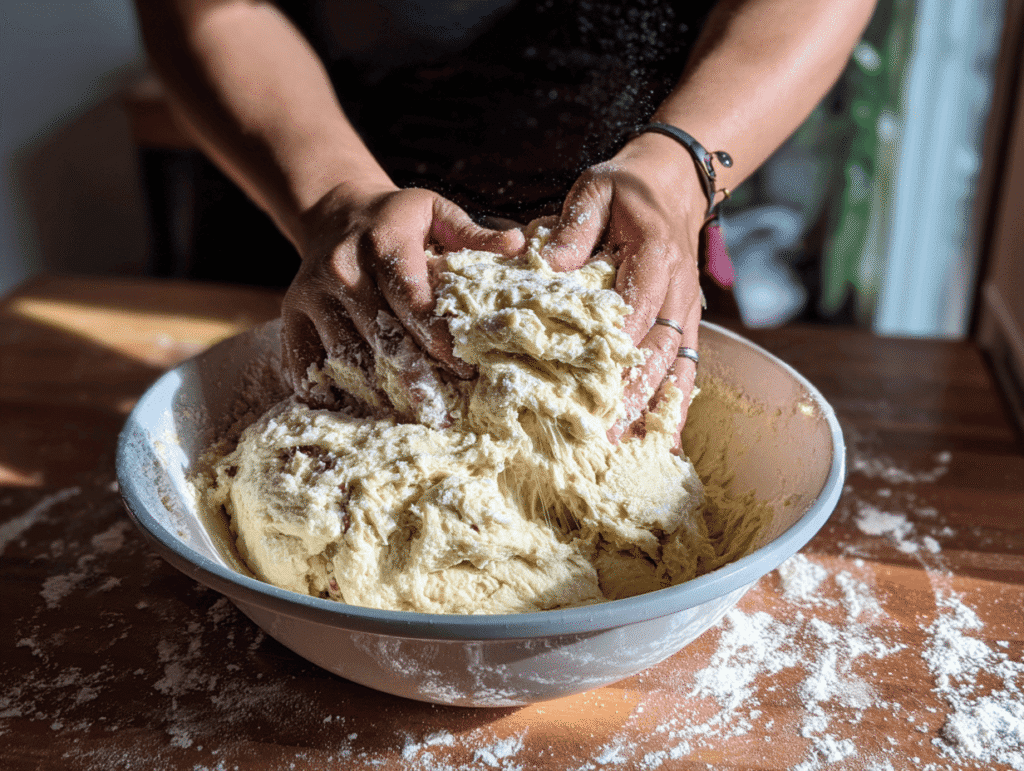
Mixing and Initial Fermentation
Creating exceptional sourdough bread recipe without starter begins with proper mixing technique. In a large bowl, whisk together 3¾ cups bread flour, ¼ cup whole wheat flour, 2 teaspoons salt, and 1 teaspoon instant yeast for your sourdough without starter. Create a well in the center and add 1 cup Greek yogurt, 1 cup warm water (80-85°F), and 1 tablespoon honey. Using a wooden spoon or dough whisk, mix from the center outward until a shaggy dough forms for your sourdough bread recipe without starter. Don’t overmix – lumps are normal and will hydrate during fermentation.
Cover the bowl with a damp kitchen towel and let this sourdough bread without starter rest for 30 minutes. This autolyse period allows flour to fully hydrate and gluten to begin developing without kneading. After resting, perform the first set of stretch and folds for your sourdough recipe without starter: wet your hand, grab one side of dough, stretch up and fold over to opposite side. Rotate bowl quarter turn and repeat 3 more times. The sourdough bread recipe without starter dough will feel sticky but shouldn’t tear. Cover and begin bulk fermentation at room temperature (70-75°F) for 4-6 hours, performing stretch and folds every 30 minutes for the first 2 hours of your sourdough without starter process.
Shaping and Final Proof

After bulk fermentation, your dough should’ve doubled in size and feel jiggly when shaken. Turn onto a lightly floured surface using a bowl scraper. Pre-shape into a round by folding edges toward center, creating surface tension. Let rest 20 minutes uncovered. For final shaping, flip dough seam-side up, fold bottom third up, sides in, then top down, creating a tight package. Flip seam-side down and use bench scraper to create tension by pulling dough toward you.
Place shaped dough seam-side up in a banneton or bowl lined with floured kitchen towel. Cover with plastic wrap and proof 2-3 hours at room temperature or overnight in refrigerator for enhanced flavor. The poke test determines readiness: gently poke dough with floured finger. If indentation springs back slowly, leaving slight impression, it’s perfectly proofed. Quick spring-back means more time needed; no spring-back indicates overproofing.
Troubleshooting Common Issues Without Traditional Starter
Achieving Proper Rise and Structure
The most common challenge with sourdough bread recipe without starter involves achieving adequate rise. Unlike traditional starters with established yeast populations, our sourdough without starter method relies on commercial yeast activated by dairy cultures. If your sourdough bread recipe without starter isn’t rising properly, first check yeast freshness – test by mixing 1 teaspoon yeast with warm water and sugar. Bubbling within 10 minutes confirms viability for your sourdough bread without starter. Room temperature significantly impacts rise time; cold kitchens may require 8-10 hours versus 4-6 in warmer conditions for sourdough recipe without starter.
Dense, heavy loaves in sourdough bread recipe without starter often result from insufficient gluten development or overproofing. Ensure you’re performing enough stretch and folds during bulk fermentation – these build structure without traditional kneading in sourdough without starter methods. Watch for visual cues rather than strict timing: properly fermented sourdough bread without starter dough jiggles when shaken and shows visible bubbles beneath the surface. If consistently getting dense results with your sourdough bread recipe without starter, try reducing whole wheat flour to 10% or switching to bread flour exclusively. Hydration levels also matter in sourdough without starter – sticky dough is normal, but if unmanageable, reduce water by 2 tablespoons.
Developing Authentic Sourdough Flavor
Creating genuine sourdough tang in your sourdough bread recipe without starter requires patience and technique adjustments. If your sourdough bread without starter lacks sourness, extend bulk fermentation by 2-3 hours or add 1 tablespoon apple cider vinegar to the initial mix. Cold fermentation dramatically improves flavor in sourdough recipe without starter – after shaping, refrigerate overnight or up to 48 hours. This slow fermentation develops complex flavors impossible with quick rises in sourdough bread recipe without starter. Temperature during bulk fermentation affects acid production: cooler conditions (65-70°F) create more pronounced sourness in your sourdough without starter.
For insufficient tang in your sourdough bread recipe without starter despite long fermentation, examine your dairy choice. Generic yogurts may contain fewer active cultures than premium brands for sourdough without starter success. Greek yogurt brands like Fage or Chobani consistently deliver robust cultures for sourdough bread without starter. Alternatively, try cultured buttermilk or kefir for stronger flavor in your sourdough recipe without starter. Some bakers add 1 teaspoon citric acid or lemon juice for extra tang, though this can affect texture if overdone. Remember, this sourdough bread recipe without starter produces milder sourness than traditional sourdough – embrace the subtle complexity rather than expecting mouth-puckering acidity.
Frequently Asked Questions
Can sourdough bread be made without a starter?
Yes! Sourdough bread can absolutely be made without maintaining a traditional starter. By using cultured dairy products like Greek yogurt or buttermilk combined with commercial yeast, you can achieve authentic sourdough flavor and texture in just 8-12 hours instead of days or weeks.
What can I use if I don’t have a sourdough starter?
The best substitutes for sourdough starter include Greek yogurt with live cultures, cultured buttermilk, sour cream, or kefir. These dairy products contain similar beneficial bacteria that create sourdough’s characteristic tang. Combine them with instant yeast for rising power and extended fermentation time for flavor development.
How to make your own starter for sourdough?
While this recipe eliminates starter needs, creating traditional starter involves mixing equal parts flour and water, then feeding daily with fresh flour and water for 5-7 days until bubbly and active. However, our no-starter method delivers similar results without the maintenance commitment.
Can I use yeast instead of sourdough starter?
Yes, but yeast alone won’t create sourdough flavor. Our method combines commercial yeast with cultured dairy products to replicate both the rising power and tangy flavor of traditional sourdough. This hybrid approach delivers authentic results without starter maintenance.
Conclusion
This revolutionary sourdough bread recipe without starter proves that incredible artisan bread doesn’t require weeks of preparation or daily starter feedings. By understanding the science behind fermentation and harnessing the power of cultured dairy products, you can create authentic sourdough bread without starter with its characteristic tang, chewy crumb, and crispy crust in just one day. Whether you’re a busy parent, apartment dweller without space for starter maintenance, or someone who’s struggled with traditional methods, this sourdough recipe without starter approach makes sourdough accessible to everyone. Start your sourdough bread recipe without starter journey today – mix your dough this morning and enjoy fresh, homemade sourdough without starter by dinner. The only thing you’ll wonder is why you didn’t discover this sourdough bread recipe without starter method sooner. This game-changing sourdough without starter technique will transform your baking forever.
